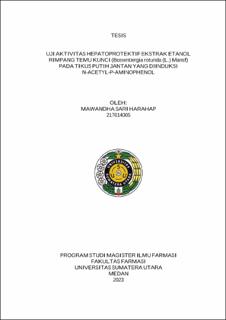Uji Aktivitas Hepatoprotektif Ekstrak Etanol Rimpang Temu Kunci (Boesenbergia rotunda (L.) Mansf) pada Tikus Putih Jantan yang Diinduksi N-Acetyl-P-Aminophenol

Date
2023Author
Harahap, Mawandha Sari
Advisor(s)
Harahap, Urip
Sitorus, Panal
Metadata
Show full item recordAbstract
Liver is the most critical organ in the body's metabolic systems. N-acetyl-paminophenol
(APAP) metabolism produces the reactive metabolite N-acetyl-pbenzoquinone
imine (NAPQI), which can cause a decrease in liver glutathione
antioxidants, mitochondrial dysfunction, and an increase in free radicals in the
liver, eventually causing liver damage. Antioxidants are required to reduce free
radicals. Temu kunci rhizome (Boesenbergia rotunda (L.) Mansf) includes
secondary metabolites in the form of flavonoids, which have antioxidant
characteristics, hence it has the ability to protect the liver from harm. The purpose
of this study is to investigate the hepatoprotective efficacy of an ethanol extract of
the temu kunci rhizome against male white rats induced with APAP.
In this study, 24 male white rats were divided into six treatment groups: the
normal control group, the negative control group, which received 0,5% CMC-Na,
the experiment group, which received ethanol extract of temu kunci rhizome
(EERTK) doses of 250, 500, and 750 mg/kgBB, and the positive control group,
which received 200 mg acetylcysteine. For ten days in a row. On the eleventh day,
800 mg/kgBB APAP was administered orally. Surgery was conducted after 16
hours, and blood was drawn. Blood samples are collected for the analysis of
indicators of liver injury (TB, ALT, AST). The liver organ was examined for
antioxidant enzyme GSH-Px, relative organ index, immunohistochemistry, and
macropathology. One way ANOVA was used to evaluate the data, followed by
Post Hoc Turkey.
Based on the results, pretreatment with EERTK significantly reduced serum
ALT, AST, and total bilirubin (TB), glutathione peroxidase (GSH-Px) activity
increased with EERTK administration, while the relative index of liver organs
decreased; however, EERTK also improved liver macropathology. The expression
of NF-κB protein revealed that EERTK inhibited NF-B protein activation.
According to the results EERTK's hepatoprotective effect in preventing APAPinduced
hepatotoxicity is due to the stimulation of GSH-Px antioxidant enzyme
defense and the regulation of NF-κB protein production, which is a transcription
factor for inflammatory mediators.
Collections
- Magister Theses [371]
